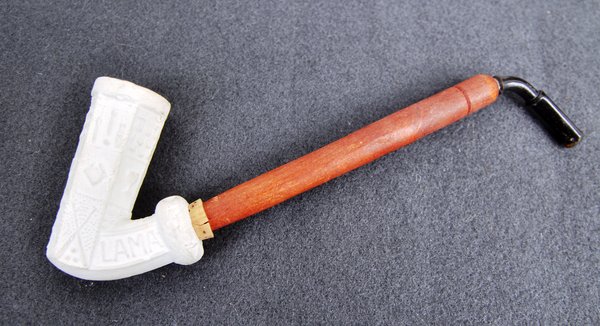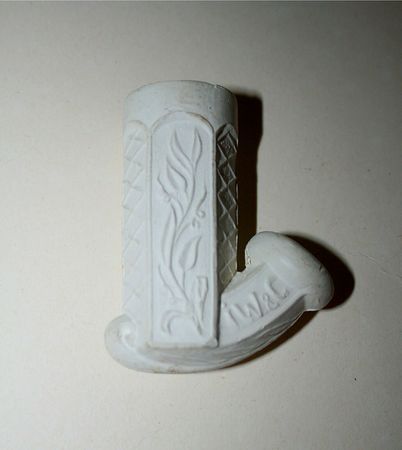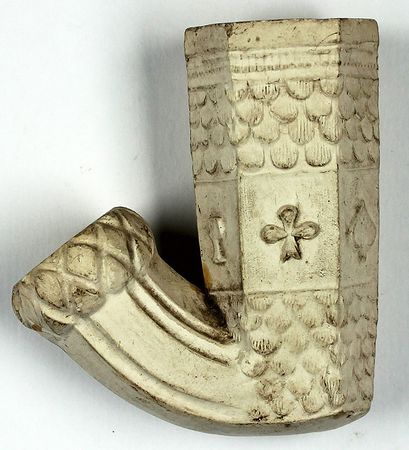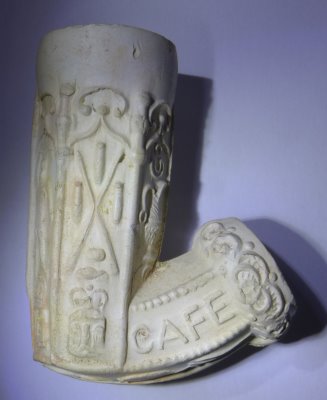Wiener Kaffeehauspfeife: Difference between revisions
No edit summary |
No edit summary |
||
| Line 10: | Line 10: | ||
Jwc1.jpg|Wiener Kaffeehauspfeife by [[J. W. & C.]], courtesy Heinz Brayer Dieken Merenberg Westerwald | Jwc1.jpg|Wiener Kaffeehauspfeife by [[J. W. & C.]], courtesy Heinz Brayer Dieken Merenberg Westerwald | ||
Mt1.jpg|Wiener Kaffeehauspfeife by [[Müllenbach & Thewald]], courtesy Museum Wolmirstedt | Mt1.jpg|Wiener Kaffeehauspfeife by [[Müllenbach & Thewald]], courtesy Museum Wolmirstedt | ||
Kaffeehauspfeife-Schilz-Mühlenbach.jpg|Coffee house pipe, Fa. [[J. Schilz-Mühlenbach]], between 1913 and 1946 (Worms Museum in the Andreasstift), courtesy Dr. Gerald Volker Grimm | |||
</gallery> | </gallery> | ||
Revision as of 12:02, 16 December 2020
Wiener Kaffeehauspfeifen (viennese coffee house pipes) are a special type of clay pipes where only the stummel is made of unglazed clay. The shank is often made of wood and the mouthpiece may be made from horn.
As early as the late 18th century, some Viennese coffee houses had their own rooms for smokers. Business-minded coffee house owners offered their guests pipes stuffed with tobacco as a service. They only paid for the tobacco, the use of the pipe was free. Which brings us to the classic Viennese coffee house pipe of the 19th century. Its tall, slender head with six facets, made of white pipe clay, is easy to recognize. In the ornament-friendly 19th century, of course, the charming ornamentation could not be missing. The repertoire included geometric patterns, delicate tendrils, flowers, vases and figures. These pipes intended for the Austro-Hungarian market were made in workshops in the Westerwald, Germany, southeast of Cologne - well into the 20th century. The astonishingly long stems were mostly made of cherry or sour cherry wood. In order to have enough suitable wood available for their production, trees were planted near Vienna, in Theresienfeld in Lower Austria. One can only hope that the horn mouthpieces of the rental pipes were replaced and washed after use ...[1]
Anyone who wanted could rent such a pipe for a small fee or for free if it was a known person for the duration of a pipe filling. The guest got a new mouthpiece, mostly they were made of goose quill and then he could indulge in his smoking pleasure. Once it was smoked, the pipe was taken apart, cleaned by the servant of the coffee house and another guest could enjoy it. We know a similar custom from other large cities, including England. There, clay pipes were borrowed in the so-called Tabagie[2] for a small fee and could then be smoked by those who did not own a pipe or who had forgotten it at home. The Kaffee Neuner on Seilergasse was particularly famous in Vienna. Famous contemporaries liked and often frequented there: Lenau and Grillparzer, for example, they quietly smoked their borrowed pipes there.[3]
Gallery
Wiener Kaffeehauspfeife by Lama, courtesy Aller-Leih
Wiener Kaffeehauspfeife by J. W. & C., courtesy Heinz Brayer Dieken Merenberg Westerwald
Wiener Kaffeehauspfeife by Müllenbach & Thewald, courtesy Museum Wolmirstedt
Coffee house pipe, Fa. J. Schilz-Mühlenbach, between 1913 and 1946 (Worms Museum in the Andreasstift), courtesy Dr. Gerald Volker Grimm



